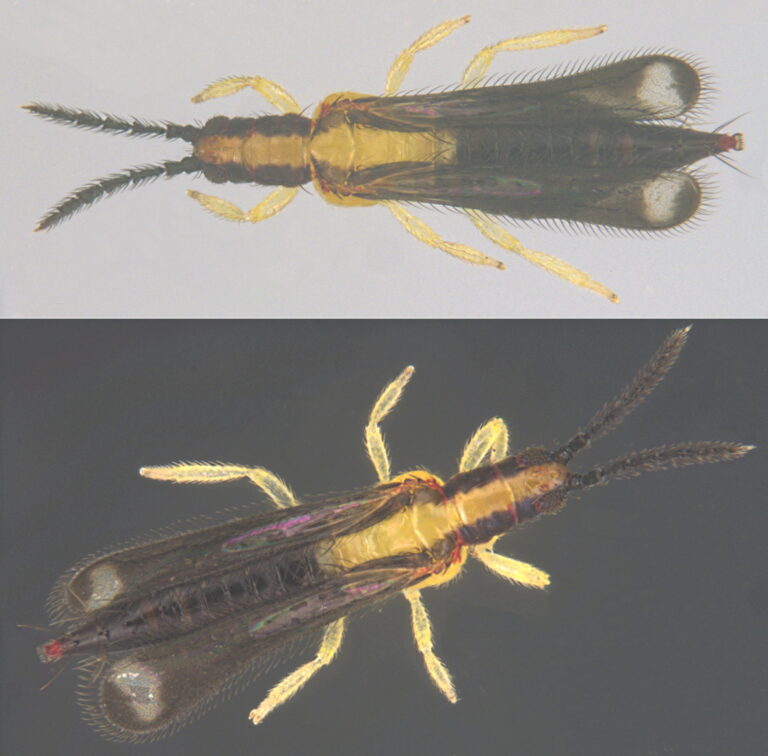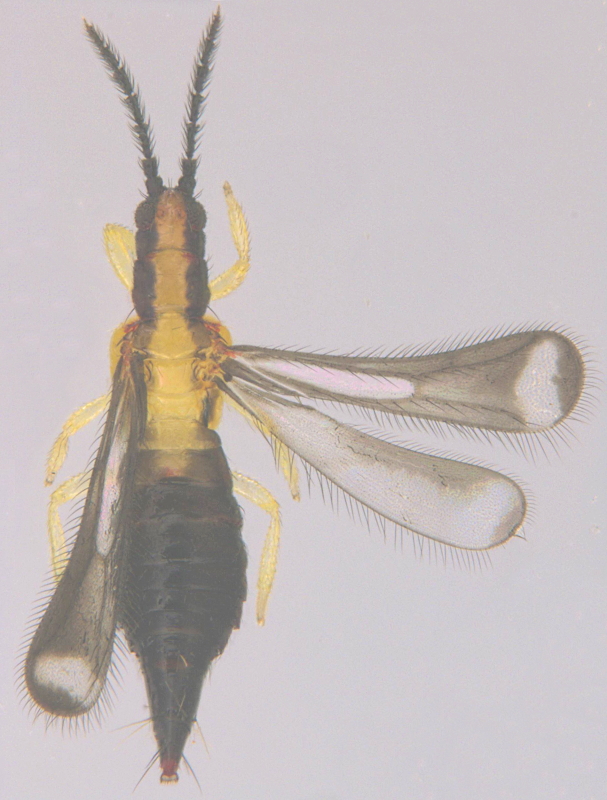
The family Aeolothripidae (Thysanoptera: Terebrantia) includes many facultative predators of other small arthropods. In the warmer parts of the world, several species are obligate predators (Hoddle, 2003), although some species are almost certainly solely phytophagous, and a few are found in flowers (Tyagi et al., 2008).
Species of the Old World genus Mymarothrips Bagnall (Aeolothripidae) are also obligate predators but have a body form and wings that resemble those of small chalcid wasps (OzThrips, 2024). The genus is highly distinctive, with racquet-shaped fore wings (greatly expanded subapically) and stout, moniliform antennae. At present, Mymarothrips includes three extant species, which may be no more than colour variants of a single widespread species (Mound & Marullo, 1998), and one fossil species, Mymarothrips groehni Ulitzka (2015), described from Baltic Tertiary Amber. The three extant species, M. ritchianus Bagnall from Africa, M. garuda Ramakrishna & Margabandhu, 1931 from India and southern China, and M. bicolor zur Strassen from Indonesia and northern Australia, exhibit slight differences from each other in the extent of shading on the fore wings (OzThrips, 2024). Diagnostic information on M. bicolor and M. ritchianus is available in online resources, Thrips of Australia, OzThrips, and Identification and Information tools for thrips in East Africa, respectively. Images of slide mounted M. garuda are included in Varatharajan et al. (2018) and Elie et al. (2021).
The purpose of this note is to record the occurrence of M. garuda on banana. The original description from Tamil Nadu (South India) was based on two specimens, one collected on grapevine leaf with Rhipiphorothrips cruentatus Hood and the other on turmeric leaves with Panchaetothrips indicus Bagnall.
A single female specimen was found to be actively moving in a colony of Stephanitis typica (Distant) (Hemiptera: Tingidae), a common pest of banana foliage, in Tamil Nadu, South India, and collected using an aspirator. Though Thysanoptera taxonomy is on a solid foundation with several online resources such as ThripsWiki and OzThrips, images of live thrips are unavailable for most species as correct identification requires examination of slide mounted material. Here, a representative image of M. garuda is given because of its unique appearance that should make it easy to identify for applied entomologists.
Mymarothrips garuda can be identified by the following set of characters (modified from Ramakrishna & Margabandhu, 1931): Female: Macropterous. Length: 1.60 mm. Body colour bright yellow and black, with reddish pigmentation over abdominal segments 3 to 6 and apex; antenna black, stout and moniliform, with strong bristles; a bright yellow median longitudinal patch extending from ocellar region to base of abdomen, broader at pterothorax; cheeks brown, pronotum brown, tinged with red along sides, medially yellow (Fig. 1). Head and prothorax longer than broad. Forewing racket-shaped, apically greatly expanded; dark greyish with a distinct transverse hyaline patch just before apex; hindwing largely hyaline except for a broad greyish strip along anterior margin and smaller greyish/infuscate patches on basal and apical margins (Fig. 2).
Mymarothrips garuda appears to be a rare species of a rare genus, as nearly all available literature from India is based on just one or two specimens. In the Checklist of Indian Thysanoptera by Tyagi & Kumar (2016), M. garuda is listed as distributed in the states of Madhya Pradesh, Tamil Nadu, and West Bengal. Rachana & Varatharajan (2017) also listed M. garuda in their Checklist of Indian Terebrantia. Maisnam et al. (2012) and later Varatharajan et al. (2018) recorded it from Arunachal Pradesh in northeastern India.
Elie, N., Yajin, L., Yanlan, X., Yanli, Z. and Hongrui, Z. 2021. Checklist of the suborder Terebrantia (Thysanoptera): generic diversity and species composition in Xishuangbanna, Yunnan Province, China. Biodiversity Data Journal 9: e72670. https://doi.org/10.3897/BDJ.9.e72670
Hoddle, M.S. 2003. The effect of prey species and environmental complexity on the functional response of Franklinothrips orizabensis: a test of the fractal foraging model. Ecological Entomology 28: 309-318. https://doi.org/10.1046/j.1365-2311.2003.00518.x
Maisnam, S., Varatharajan, R., Singh, O.T. & Chakravorty, J. 2012. Thysanoptera fauna of the Itanagar Wildlife sanctuary (Arunachal Pradesh). Records of the Zoological Survey of India, 112 (Part 3): 35–43.
Mound, L.A. & Marullo, R. 1998. Biology and identification of Aeolothripidae (Thysanoptera) in Australia. Invertebrate Taxonomy, 12: 929-950. https://doi.org/10.1071/IT97014
Rachana, R.R. & Varatharajan, R. 2017. Checklist of terebrantian thrips (Insecta: Thysanoptera) recorded from India. Journal of Threatened Taxa, 9 (1): 9748–9755. https://doi.org/10.11609/jott.2705.9.1.9748-9755
Ramakrishna Ayyar, T.V. & Margabandhu, V. 1931. Notes on Indian Thysanoptera with brief descriptions of new species. Journal of the Bombay Natural History Society, 34: 1025–1040. https://www.biodiversitylibrary.org/page/48294404
Tyagi, K., Kumar, V. & Mound, L.A. 2008. Sexual dimorphism among Thysanoptera Terebrantia, with a new species from Malaysia and remarkable species from India in Aeolothripidae and Thripidae. Insect Systematics and Evolution 39: 155–170. https://doi.org/10.1163/187631208788784093
Tyagi, K. & Kumar, V. 2016. Thrips (Insecta: Thysanoptera) of India - An Updated Checklist. Halteres, 7: 64–98.
Ulitzka, M.R. 2015. Two new species of Aeolothripidae from Baltic Tertiary amber (Insecta: Thysanoptera). Palaeodiversity, 8: 89–94.
Varatharajan, R., Singh, K.N., & Rachana, R.R. 2018. On the collections of predatory thrips (Insecta: Thysanoptera) from NE India. Journal of Biological Control, 32 (1): 8–13. https://doi.org/10.18311/jbc/2018/16149

Fig. 1. Mymarothrips garuda Ramakrishna & Margabandhu, dorsal view. NRCB-TE-1.

Fig. 2. Mymarothrips garuda Ramakrishna & Margabandhu, dorsal view with wings spread. NRCB-TE-1.